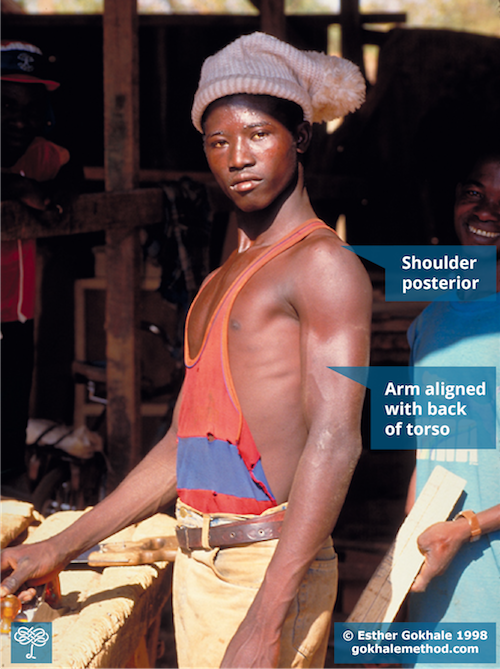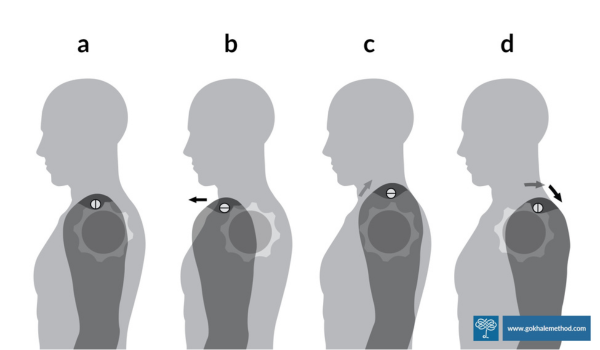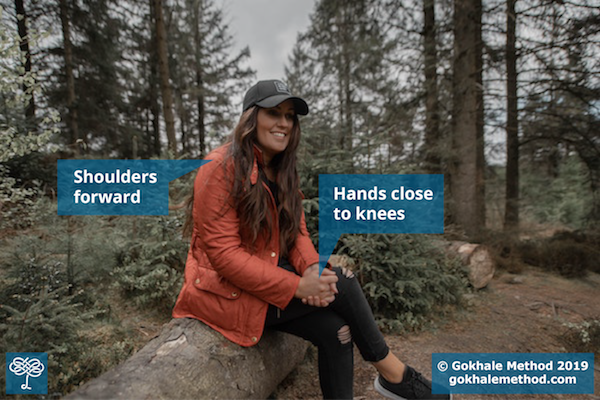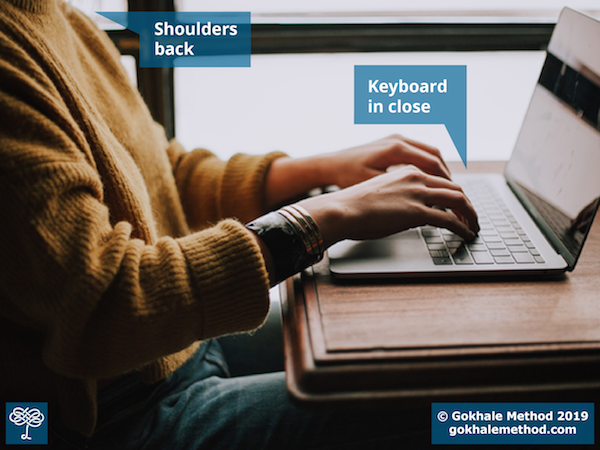Your Most Striking Posture Feature: Shoulder Position

The arm and shoulder of this African carpenter align with the back of his torso.
One of the most striking features of good posture is the position of the shoulders. The posture of this African carpenter shows how, with the shoulders well back, the arms align more with the back of the body than the front. The side of the chest and ribcage are clearly visible. Positioning the shoulders well brings you many benefits. It aligns your shoulder joint correctly, avoiding impingement, bursitis, arthritis, tendinitis, and general wear and tear. It improves circulation to your arms, as well as your breathing pattern. Optimal shoulder positioning improves athletic performance: throwing, punching, and swinging a racket or bat are all mechanically advantaged when your shoulders remain “home.” And last but not least, it helps prevent hunching your upper back and protruding your head forward.
If your shoulders have drifted forward over the years, a shoulder roll can ease your shoulders home into a healthy position. This maneuver gently realigns the many structures of the shoulder joint and immediately relieves stress and increases comfort. Punctuating your days with occasional shoulder rolls will gradually lengthen any tight, shortened muscles in the front of your chest and shoulders, giving you a wider, more open chest.

Michelangelo’s ‘David’ shows the shoulders well behind a wide, open chest. Original image courtesy Igor Ferreira on Unsplash.
Your shoulders will be increasingly happy to settle back, returning nearer to where they were when you were a young child.

Children have naturally well-aligned shoulders.
If you don’t already know how to do a Gokhale Method shoulder roll, or would like to refresh your shoulder roll technique, this short video will show you how to gently roll each shoulder forward, up, and back.
The shoulder roll is so gentle you can repeat it whenever you need. (If you already have some soreness in your shoulder, then wait until it has recovered, or try mini shoulder rolls — you do not want to cause pain.) However, the aim is not to be continually rolling your shoulders!
Here are my tips for making your shoulder roll last longer:
Tip 1: Once you have taken your shoulder forward, up, and then back, remember to release your arm down right there — you don’t want to just scoop your shoulder full circle! Check that you have fully relaxed the muscles on the top of your shoulder and neck. Feel the weight sinking down to your elbow. Expect this to both look and feel different from your old position — that’s progress!

Ratchet the shoulder soft tissue back in a similar way to a gear mechanism.
Tip 2: When sitting with your hands on your lap, place your hands close to your body and not close to your knees as this will tend to pull your shoulders forward again. Let your elbows drop straight down and be heavy. You can also hook your thumbs on your belt, pant rim, or pockets.

Your shoulders will be pulled forward if your hands slide too close to your knees.
Tip 3: Sit or stand up close to any task you may be doing. That may be typing, chopping vegetables, or working at a bench. This will make it easier to keep your shoulders rested back. You may be surprised how this simple step can help you break old habits of slouching the shoulders forward to reach things.

Create new posture habits around daily tasks.
Tip 4: Notice how you go to move your coffee cup, pen or computer mouse — are you automatically reaching your shoulder forward? With your shoulder back and relaxed after a shoulder roll, try extending your arm by opening up the angle of your elbow.
Tip 5: Before driving, adjust your position to accommodate and keep your shoulder roll. See my blog post, How to Modify Your Car Seat for a Pain-Free Ride.
These five tips will help your arm, shoulder, and upper back muscles to work harmoniously and pain-free. I look forward to sharing further tips in Part 2 of this blog, and exploring when it is absolutely ok to pull your shoulders back!

Do you have advice about
Do you have advice about stance while washing dishes? That's my biggest source of back pain now. You've solved all the others.
Washing dishes requires a
Washing dishes requires a small hip-hinge. It takes some experimentation to learn where your feet want to be positioned so that after hip-hinging forward your hands are in the right place for the task at hand. In Part 2 of this blog post we'll talk in more detail about the extra muscle contractions that need to happen to make all of this work out. If you go to one of our referesher classes for alumni, ask to review and practice this specific action.
So glad to hear that all of your other sources of back pain have been resolved - that's wonderful. Congratulations!
Can't wait!
Can't wait!
Thank you so much for this.
Thank you so much for this. One of my remaining issues with posture is my neck being forward and the shoulder rolls are perfect for that. I have trouble trusting the hip hinge fully though so I look forward to part 2 of this. One big issue is when I'm cooking, the countertop is just so far down. I'm not particularly tall (around 5'9" or 5'10") but I'm in Japan, and I guess the counters here are made for shorter people. The shoulder rolls are helping me remember not to round my shoulders and reach down.
Thank you for this blog post.
Thank you for this blog post. I've studied your book closely, and I understand the value of doing shoulder rolls and enjoy doing them throughout the day. However, I have chronic tension somewhere in my right shoulder, the source of which is difficult to pinpoint. When I perform a shoulder roll on that side, after taking my shoulder forward, up, and then back, I feel some internal tension. The tension increases as I drop my arm down until there's a "pop" that releases it. It's not painful, but it's more than a tiny pop. It feels like it's my collar bone that's popping, or something right underneath it.
I've tried various types of stretches and seen various practicioners, but have never found the source of the tension or learned how to address it. I realize you can't diagnose at a distance, but I'm wondering, with your knowledge of the body and the mechanics involved with the shoulder roll, if you might be able to share some hints or clues. Or perhaps you've helped someone with this before.
Thank you very much.